#writing tutorial
Text
Liv’s {Totally Optional Non-Mandatory Completely Voluntary} Pointers for Fleshing Out Character Relationships
Hi I’m liv e. and by middling demand I am going to blab a liiittle* bit about relationships.
So I will start by saying that I’m trained & licensed as a marriage and family therapist. So this is kind of what I do all fucking week. And I like this whole writeblr thing so why not make it fun and about fiction instead. LOL.
The purpose of this liiiiittle** post is to offer some ways in which you, a writer (great job btw!), might deepen your own understanding of the relationships between two or more characters in your writing. More specifically, by thinking a little deeper about how relationships function in real life.
These are ways in which I might conceptualize a relationship between people who seek my services as a clinician.
A small disclaimer: the VAST majority of my work is with couples (because I. prefer to see couples over families, lol), so this advice is coming from that perspective. Please keep in mind also that there are certainly infinite other ways to think about relationships. This is just the way I was trained. Or at least, the parts of my training that resonated with me the most, especially as I began writing more seriously.
My hope is that reading and practicing/toying around with these tips will help add another dimension to how relationships play out in your writing. So um. Cheers! Let’s chat.
*it’s not a little. it’s a lot.
**it’s a long post.
i. What I Say vs. What I Mean
When was the last time your partner or good friend pissed you off?
Maybe they were flippant about your feelings. Maybe they blew you off to hang out with someone else. Maybe they keep loading the dishwasher like a neanderthal.
And did you say to them, “Baby/honey/sweetums/bestie, it really upsets me when you load the dishwasher like that. I’ve asked you to do it X way several times, and it feels like you’re not listening to me, or that you don’t care about how I feel” ?
Probably not? Because, hello? (If you did, first try, then, wow! you’re a better person than i’ll ever be.)
You might’ve said “Dude, stop cramming shit in the dishwasher like it’s a fucking suitcase,” or “Haha, wow, again with the dishwasher. Awesome. No, it’s like, whatever.“ Or you might not’ve said anything at all, on purpose.
There is a tension that exists, there, in the CONTRAST between what we are thinking/feeling/meaning (e.g., I love you/I miss you/You hurt me) and what we are communicating via our words and actions (e.g., You never make time for me/You’re so lazy/You’re such a(n) [expletive of choice]).
That tension is ... really fucking interesting to read, huh!
Personally, I have a lot of fun watching the needs/wants/feelings of a character (that we might be privy to, as readers) get filtered through their unique... voice.
So say you write a character who is quite rough around the edges, and not very skilled in affection. They have a deep yearning to be close to [love interest], but they just aren’t accustomed to languaging their true feelings. Maybe we see how scared they are of putting their feelings out there. It’s vulnerable. It’s terrifying.
So instead of “I really care about you, [love interest]”, maybe it comes out something more like “Don’t you have anything better to do with your time than follow me around all fucking day?”
And we, the readers, are like, wow! That’s not what you were thinking at all man! You’re so bad at this, that’s awesome.
So the point of all this is that it’s very helpful to clarify for yourself, in any meaningful interaction between characters in or soon-to-be-in a relationship:
What are the characters individually thinking during this interaction? What are the emotions that are present? How does it show in their body or their movements? Are they careful not to let these things show, or do they not notice at all?
How are they expecting this interaction to go? (Are they afraid something might go wrong? Are they looking for a certain reaction from each other?)
What DON’T they know about what the other person is thinking? What are their assumptions about how the other person perceives them--in general, and in this moment?
What is the GAP or the CONTRAST between all of the above and what actually ends up coming out of their mouth? Or what actions they end up physically taking (or not taking)?
Are the characters aware of their own contrast, here? How do they feel about it? Or, do they think they are being perfectly congruent?
In this way, you have the ability, as a writer, to create some devastatingly (or delightfully) poignant moments between characters. These are the moments that can really sell the reader on the relationship--its importance (why are you showing us this?) and its appeal (thank you for showing us this, this blew our tits off, etc).
ii. Tender Spots and How to Attack Them for Fun and Profit
So we’ve got issues.
What are the things that really fuckin get at you? Those topics that, when brought up, make you really upset and really defensive at like, mach speed. Maybe you’re insecure about your skills. Maybe it really bothers you when people see you as weak/unintelligent/a burden/unattractive. Maybe you have a rough and complicated relationship with a family member.
So these can be thought of as, like, tender spots (lol). You can also think of them as “raw” spots, sensitive spots, or triggers.
Figure out what your characters’ are!
This is another key way in which you can create deep and believable interpersonal drama--Character A (accidentally or intentionally) stomps all over Character B’s sensitive spots. So to speak.
A very cursory and relatively uncomplicated example of this in action:
Tasha and Mimi are two adults in a committed partnership.
Mimi’s got a real fucking chip on her shoulder about being seen as a burden--her father always went to great lengths to make sure she knew just how much he did for her, just how many opportunities he passed up in order to raise her, just how great his life would have been if she’d never been born.
Tasha is the oldest of five siblings. She was frequently tasked with their care, growing up. She did her best not to complain, as her parents were always very busy working to keep a roof over their head. So, Tasha did her part. She would’ve loved to rest and play and goof off like other kids and teens, sure, but it never felt possible with all of her responsibilities.
Mimi is suddenly injured and is unable to do certain things on her own that she had been doing before. Tasha goes about taking care of these things as well as taking on certain other tasks on her own that the pair of them may have tackled as a team before. Tasha feels stretched very thin by the workload, but is deeply concerned about how Mimi feels. There’s nothing to be done about the situation, she reasons, so there’s no point in complaining about how stressed out she is.
Mimi offers to help to the best of her ability, but Tasha is very concerned about her, and insists that Mimi rest and not exert herself. Mimi insists back. Tasha insists back back.
Mimi points out how stressed Tasha must be. Tasha agrees that she is stressed, but does not elaborate on her feelings. Mimi assumes that Tasha must think that she is a burden.
Mimi then becomes very emotionally activated--she is reminded, consciously or unconsciously, of how shitty it felt to have her father tell her over and over again what a burden she is, and how better off he would be without her. So this must be how Tasha really feels about her, Mimi accuses.
Tasha, who is very stressed but who cares very deeply for Mimi and her well-being, and who does not see Mimi as just a burden, becomes very activated in turn--she feels maligned and misunderstood. And now she certainly can’t talk about how stressed out she is, because it will only convince Mimi that she is right.
So Tasha is now convinced that she must continue to hold her feelings in in order to keep the peace--she’s reminded of her childhood spent taking care of others, and how she never felt allowed to express herself.
This example is obviously from a very zoomed-out view, chronologically, and is not exactly the way we would see it written in fiction (fiction is much more moment-by-moment and, well, exciting, usually). BUT we can see where Tasha and Mimi’s sensitivities lie, and how they specifically hurt each other with their behavior (unintentionally, in this case) by stomping RIGHT ON those sensitivities.
Readers love drama. And drama makes the plot go ‘round! So don’t be afraid to lay it on them!
In your (very good and compelling) writing, ESPECIALLY if you want to write engaging relational conflict, you would do well to clarify what your characters’ deepest sensitivities are. Consider the following:
What needs went unmet for them, growing up? A very cliche therapist-y question, but for good reason--our upbringing is where many of our deepest insecurities originate.
Additionally/alternatively, what do your characters understand to be their role in relation to other people? E.g., are they always the caretaker, the burden, the comic relief, the heartbreaker, the lonely hero, the boss? How did they first get this idea of who they’re ‘supposed’ to be towards others, and how was this reinforced throughout their life? Are they satisfied or dissatisfied with their ‘lot in life’? What do they hate about their ‘role’, if anything?
What sorts of situations might remind them of what they hate most about this role? E.g. ‘I enjoy taking care of others, and I’m good at it, but my partner gets upset if I discuss how stressed I get sometimes--I’m never allowed to express myself.’ How can you incorporate these situations into your story to create conflict?
How does your character respond when these sensitivities are triggered? Do they lash out? Do they retreat and get quiet? Do they ghost people altogether?
What do they think will happen if they are unwilling or unable to fulfill this role in their relationships with others? E.g., ‘My partner will leave me if I am not a good caretaker’, ‘Nothing will get done right if I’m not the one taking charge’, ‘If I don’t keep others at arms’ length, even if they say they love me, I’ll end up hurt.’
This is another way in which you can help your relationships really come to life! Anyways. Read on for more cheer and relational joy!
iii. We’re Attracted to What Hurts Us Sometimes, AKA Oops! I Ran into the Knife, Ten Times,
(less of a part 3 and more a part 2.5, but it was simply too long. so,)
So maybe you have a good idea of what your ideal partner/bestie looks like. It’s probably any number of positive traits: kind, considerate, good sense of humor, shapely posterior, ambitious, active, fun-loving, studious, etc.
What probably don’t make the list are things like: emotionally distant like my mother with whom I long to have a reparative experience.
Maybe you’ve witnessed (or been in) a relationship wherein all parties can be described as ‘just so bad for each other’. And maybe this relationship should not have lasted as long as it did (or shouldn’t be lasting as long as it is). And maybe you’re like--’Why are these assholes still together?’ Or, importantly: ‘Why did these assholes get together at all?’ The answer may surprise you! But more likely, it won’t.
Sometimes, we pick people on purpose specifically because they stab us right in the sensitive spot (again. so to speak).
(i should clarify before moving on: I am specifically NOT talking about relational abuse, here. That’s kind of an entirely different subject that is like. the cousin of this subject. In this discussion, I specifically mean relationships in which there is no major power differential--you’re just bad for each other. These relationships can be what we might call ‘toxic’, sure, and painful, but not abusive. The distinction is important, moving forward. ok ty)
[Author’s Note: I need everyone to know that I wrote and subsequently deleted 700 words here because I realized they didn’t make any fucking sense ok. let’s try this one more time.]
Essentially, it’s a known phenomenon among humans that, when we have experience with relational distress in the past (e.g. a partner who neglected you emotionally, or parents who disregarded boundaries you tried to set), we like to seek out similar people with whom to form relationships. Weird! But not really.
The human brain seeks closure and resolution--where we couldn’t get things to work out with our parents, or our exes, we try to get the same situations to work out next time, with someone new.
Let’s look at another example, together. Take my hand,
Suppose you write a character (Character A) whose mother was in and out of their life from a young age, and never seemed to prioritize them. Now suppose you are looking to craft a fraught or tragic or dramatic romance (or other relationship) with this character. Using what you’ve written of your first character’s backstory, you can do just that!
It’s perfectly believable, you know now, for your Character A to pursue a love interest (Character B) who has a tendency to... not want to stick around. Maybe this love interest seems to fear commitment and intimacy.
Now, maybe Character B in actuality has a very dangerous profession that requires that they maintain the utmost discretion, and be ready to flee anywhere at a moment’s notice. Maybe the fate of the city/kingdom/nation/world relies on B’s profession.
It probably doesn’t make them leaving all the time hurt A any less, though.
Character A, unconsciously or not, is determined to make things work this time around. As the relationship deepens, B is faced again and again with the choice--stay, for your love, or go, as duty commands. Maybe they’ve taken a vow for their profession that is no light thing. They leave, time and time again.
Character A, unconsciously or not, remembers this feeling--it’s an old one. Mother, time and time again, chose something else over them. It would be understandable for A to feel a deep anger towards Mom and B both. Maybe A takes drastic action to get back at B (action that is also, symbolically, retaliatory towards Mom)--maybe they cheat on B, or do something that endangers their own safety.
When all they really want is just to get B to stay.
It’s probably very clear now why it’s not so simple a thing for A to choose to date someone more consistent--this is something that goes beyond B alone.
In this way, you can very easily weave themes into the relationship(s) of your main characters. Maybe the story of A explores the pain of abandonment, or loneliness. If B is the protagonist, maybe the story explores the way we excuse our shitty behavior in relationships (maybe the job is a pretext--maybe they really are scared of commitment), or maybe it’s about the dilemma of duty over love.
Relationships don’t always make sense. Or rather, they do make sense, just in a different way than we might expect. You can use this understanding now to intentionally explore a number of complex relationship dynamics, and to create nuanced (but sympathetic) characters. As you do, consider:
In your existing characters’ relationships--what keeps these assholes together? Why do they have to be with each other, as opposed to anyone else? This is important, again, for selling the reader on the relationship, especially if it’s your work’s main relationship.
What initially attracted your characters to each other? Consider again from the previous section (what is this, a fucking textbook?) the historically unmet needs of your character(s).
How do your characters go about expressing their needs? Think again about CONTRAST here--what is the discrepancy between what the actual need is, and how the character seeks to fulfill it? E.g. ‘I need to keep B from leaving me, because it really hurts me when they go, so I’ll go risk my life just to keep their attention (rather than express this pain to them).’
What similarities, if any, exist between your MC’s relationships with the people in their present lives, and your MC’s childhood relationship(s) with their caregiver(s)? Could you expand on/deepen any similarities in your writing? What themes might emerge if you did?
iv. Change / The Arc
So you’ve got your work’s central relationship. It’s believable, it’s just the right amount of dramatic, it’s suitably tragic, and just all-around devastating. People will cry. Great job!
Now what?
Well, that depends--what ending do you envision for your relationship?
If they remain together, do they get the happily ever after? The happy-for-now? Is the reader left to wonder about whether or not their relationship will survive?
Do they not make it at all? Are they separated by tragedy? Do they crash and burn? Or maybe they try their best, but despite how badly they love each other, it’s just not enough?
Whatever the Point B of the relationship is, if it’s central to the work, you’re gonna want to have a clear arc in there. Or not, idk, I’m not your mom.
You might already know, if you inhale every piece of writing advice you come across (like me), what makes a compelling character arc. The good news is that it’s much the same with relationships! Kind of.
Systems (relationships) tend towards homeostasis. Without deliberate intervention, relationships want to remain the way they’ve always been. Just like people!
And just like characters, relationships need a reason to change. Like a catalyst, or a motivation. Whatever the hell you wanna call it.
It’s not always, like, complicated to figure out the driving force behind change in your central relationships. Sometimes the pieces fall together!
Pay attention to the characters within the relationship--as your characters progress through their arcs, their relationship will naturally shift. It will probably not look exactly the same as it did when it began--there might be similarities, of course (they’re not entirely different people.. usually. And there’s a beauty to bookending a story with the familiar, certainly). But in this case, the relationship can be thought of as an extra character, almost. It’s unsatisfying to read a whole story wherein a central character stays exactly the same. It’s further strange and incongruent for a relationship to stay exactly the same while the characters have like, achieved actualization or whatever.
Outside events can force change on a relationship, just as they do individual characters. A couple that’s close to Characters A and B get married--and A & B start to wonder what their future together even looks like. B’s company hires a fiiiine honey, who’s exactly B’s type, and A starts steaming about it. A pandemic ravages the nation, and to prevent the spread of the virus, A and B have to stay inside togeth
YOU GET IT ok anyways I’m fucking tired of writing. If you’re wanting to develop the arc of your MCs’ relationship(s), think on some of this:
Do your characters see any problem(s) present in their relationship? Are they all equally aware of the problem(s)? Do they agree on what the problem(s) are?
How secure are your characters in their relationship? If anything could possibly cause doubt and conflict to arise, what is it?
Where do your characters see their relationship going in the near future? In the far future? Do their visions align? If not, how do they differ? Do they even want the same thing?
Is the arc of the central relationship congruent with the arcs of the characters who comprise it? I.e. does the relationship remain exactly the same as it was when it started, despite the characters undergoing wild metamorphoses? Is the reverse true?
When you think about their relationship, INDEPENDENT of any ending you may already have decided, where do you see it going? Like, where do these people feel like they’re headed, realistically? Does this align with the ending you’ve decided on for them? If not, this doesn’t mean you’ve written a bad relationship or anything, it’s just a possible sign that some really intense shit might have to happen in order to shift their course, y’know? Or not--the world is your oyster and you are the God of your own creation!
What are you trying to say with your story, and do the arcs of the central relationships reflect that message?
final thots
If you read all that shit, thank you. I wrote it all in one sitting and posted it without proofreading 💜
In all seriousness, I want to emphasize that, although some of these aspects of relationships are most visible in rels with a lot of anguish and maybe even some toxicity, you by no means have to write this kind of relationship in order to make use of these tips. You could write a very Normal couple!
The idea is to offer you some avenues through which to consider aspects of your characters’ psychology and personalities, and how they mesh or clash with their partners’ or besties’.
Anyways I hope this was helpful. I love talking about relationships I could literally go on and on all day. Which I kind of just did so. lol.
I’ve been liv and I’ve got two main WIPs I’m working on right now: The Romance of the Demigods and The Marking Blood and they’re full of really really super normal relationships and examples of me definitely taking my own fucking advice.
Cheers and happy writing! 💖💖💖
#writing advice#writing tips#writeblr#writers on tumblr#writers of tumblr#writeblr community#writing community#writing tutorial#how to write romance#i guess#lol
837 notes
·
View notes
Text
★ ៸៸៸ FRIENDSHIP 1 ╱ post ❜ ✸ ៸ !?!
Good friendships can turn a decent story into a memorable one as, it not only does it make the reader care more about the story, it adds emotional weight to the story.
But there's one problem. Good relationships are difficult to write. You thought writing romance was difficult? Well, writing friendships is a whole new level of difficulty.
Romances normally rely on professions of love and staring into one's eyes for lengthy periods of time. But, how do you develop friendships?
# ៸ make each character their own person.
If a character's only purpose in the story is to act as "the friend", then it's guaranteed that they will be a flat and uninteresting character. This will lead to a friendship that no reader will be invested in.
Unfortunately, a lot of stories are like this ― you have your main character, and then their 1-dimensional friend who might crack a joke every once in a while.
We have some good examples from movies like Samwise Gamgee from The Lord of the Rings. He isn't just "Frodo's friend" who tags along. He's a gardener and a cook. He has a fascination with elves, a crush on Rosie, and a bad habit of eavesdropping. He is loyal, brave, and can persevere even when there is seemingly no hope.
You see this is in Toy Story as well. Even though Woody and Buzz both have the same goal ― to escape Sid's house ― they both have different journeys. The story means different things to each of them. Woody learns to not be as selfish and Buzz struggles with accepting that he is just a toy.
# ៸ give them something in common.
Once you have fleshed out your characters, you need a reason for them to be friends. What brought them together? What gives them the reason to hang out? You need to give them similarities.
This can be a number of different things, like:
★ Status
★ Hobbies
★ Struggles
★ History
★ Background
★ Interests
★ Enemy
★ Goals
★ Dreams
# ៸ give them meaningful differences.
Once you've established their similarities, it's time to dig deeper and create their meaningful differences. Don't just make your characters different. Give them meaningful differences that can build off of each other.
With those differences, your characters can help support their strengths and build them up during their times of weakness. This can lead to a strong friendship.
Here are some great ways to give them differences:
# ៸ skills.
★ One of the friend can be smart in terms of intelligence while the other is good at using her hands and inventing stuff.
★ One might be good at coming up with plans, while the other might be good at improvising when the plan goes awry.
# ៸ conflict resolution.
★ If there is a bully bothering them, one might want to go and blow up at the bully, while the other chooses to ignore it.
★ If they are having an argument, one friend would want to talk it out maturely, while the other just likes to play devil's advocate and throw more heat into the argument.
# ៸ personality.
★ One is confident and sly while the other is shy and awkward.
★ A is cold and determined while B is relaxed and compassionate.
★ B is an easy-going pleasure seeker, and B is a serious planner.
# ៸ method of action.
★ Both friends are trying to break into a house. One will look up videos on YouTube about how to pick a lock. The other friend will just break the window with a rock.
★ The two friends are trying to persuade someone to do something. One friend uses bribing techniques, and the other friend uses a more passive-aggressive approach.
# ៸ reaction.
★ One friend with freak out and the other friend will stay calm.
★ A will get discouraged and want to give up, and B will encourage them to keep going.
★ One person is terrified out of their mind, while the other tries to stay positive.
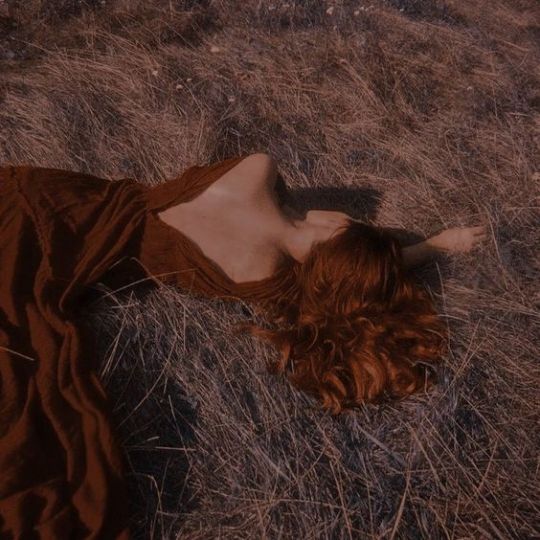


#writing advice#writingadvice#writingtips#writing tips#fictionwriting#writersociety#writing promps#writing tutorial#writing help#writing tricks#character tips#writers on tumblr#moon-delia#friendship
634 notes
·
View notes
Text
So, You Want to Write a Sword Fight.
Welcome to Your Local Sword Girlboy’s crash course on how to write a sword fight! We’re going to cover all the basics, from understanding context, to pacing, even some good ways to research! So buckle up gays, and let’s learn How to Sword.
First, what kind of sword are you wielding? There are so many different swords and forms and they’re all very different. But not only in the way you might think. Obviously the way the swords are held and wielded and the weight they have makes a difference how you write the battles, but even more so than that is TYPE OF FIGHT. Sabers, Epées, and Foils all have specific ways their bouts are set up and executed, and it has to do with a highly important cultural system of honor. Is this an honorable bout? Or a fight for survival? Or a fight for revenge? How much do these characters respect each other and how desperate are they?
This will affect the setup of the fight more than you think. For example, the target area. Or other weapons involved. If it is an honorable fight between two parties that respect each other, they will only hit on the front area of each others’ target, and will only make contact with their blades on each other. If it is a fight for survival, however, all bets are off. Any area on each others’ bodies is valid target area, and they might be more inventive while fighting, like slamming each other with the hilt, or using another improvised weapon nearby to win. It’s important to consider.
Now let’s talk about types of swords specifically. Sabers, Epées, and Foils are all incredibly light and whippy, and are held with one hand. They can be maneuvered very fast and can perform some very fast actions, and are GREAT for feinting (more on this later). They can change direction quickly with a whip of the fingers, and are usually used in very honorable bouts. Foils and Epées are for stabbing, while Sabers are for slashing opponents. All of these swords, though, use VERY small and quick movements. The fighter wielding one of these even makes themself smaller with a squatting stance and only one side facing the opponent. Everything is quick and precise. Footwork is key.
Rapiers and cutlasses are heavier, but still operated with one hand. These are favored by pirate types, and are used for slashing and sometimes stabbing. Another detail is that these can also be accompanied by a parrying dagger, held in the opposite hand as the Rapier and used for blocking the opponent’s blade out of the way.
Now the one you’ve been waiting for, longswords and broadswords (and lightsabers as well). These are usually two handed weapons, but can be one-or-two handed. They are heavier, and take more strength to control, but believe me when I say they are NOT clunky or slow. You CAN perform a feint with a longsword. I HAVE done it before (not successfully, but that’s just a skill issue on my part, let’s not dwell on it). The way these swords are maneuvered are with wider swings, for cutting OR slashing, and to protect the whole body. Footwork is important as well, but it’s terrible on the knees if you run too much with these (because they’re so goddamn heavy) so it’s not like you can run a marathon with a longsword like you can with a foil or saber. (of course if it’s a lightsaber all bets are off bc that thing is made of light and it's wielded by a space wizard so whatever).
Alright next. Let’s get GRANULAR. Let’s talk about very specific types of attacks and blocks and how to phrase this. Now, don’t worry, you don’t have to be a fencing expert to talk about the specific moves, because the audience will understand what you’re saying. It’s just about being specific enough to where you can paint a picture in their heads but not too specific to where the fight loses its suspense.
So, first, let’s talk about attacks and blocks, and what to call them. For any sword, extending the blade is holding it out in front of you. Thrusting is when you make a jabbing attack with the blade. And finally, lunging is when you throw your body forward with the attack, specifically throwing out your front leg and leaning into it, while keeping your body level with the floor to keep balance and make it easy to recover into a guard position.
Now for blocks. Pushing the blade out to block the opponent’s blade is called a parry. When you attack your opponent back immediately after taking their blade in a parry, it’s called a riposte. You don’t need to use this word, though, because I’ve found that just saying something like “They parried her blade and then thrusted towards her chest,” works quite well.
SIDE NOTE: if both of your opponents have the same pronoun set, I’m so fucking sorry. It doesn’t get any easier. It’s the Gay Fanfiction Dilemma, I’m afraid. But if you’re already versed in that, use the same workarounds for pronouns and titles for fighting as you do for fucking, it works pretty much the same way ;). (But PLEASE don’t be afraid to use their names. I promise nobody is going to kill you if you say the characters' names twice in a single paragraph. It’s MUCH better than having to read “the blond” or “the tall one” or “the younger woman.”) Basically, just use their names a lot. It’s quicker and I promise you it works.
Now where were we? Ah yes. Attacks and blocks. I already covered those, but surprise, there’s a secret third thing, and it’s my very favorite move. Feinting. It’s quite simple really, it’s an extension of the blade, a faked attack, to get your opponent to try to parry or block or move their blade, only to switch your movement to avoid their blade and attack them back. It’s fun and can be extremely effective, and it also can be used in many different types of ways. Any way you can get your opponent to try to parry your blade in one place, like a high or a low attack, expect where their blade is going to be, and then avoiding it works as a feint. Or you could engage the blade, and move it around with your own blade to get it away from your target area and slide in for a riposte. This is my specialty. And it makes a KILLER shiiiiiiing sound as well. It sounds confusing, but it can actually be written quite simply. Let’s give an example:
“A thrusted out their blade in a feint. But just as B’s blade leaped for it, A withdrew their arm and took B’s blade up in a quick engagement. They swung it around and metal scraped against metal as A pushed B’s blade away from pointing at their chest to a harmless position beside their thigh. Then, in the same flowing movement, blades still locked, A pushed their blade back up for a deadly thrust at B’s chest.”
Not bad, if I do say so myself. Although this comes from having executed that maneuver a hundred times personally. There’s still hope for you though, as a non-fencing sword writer, I promise! You just gotta research and read a bit. But more on that later.
Next let’s talk about footwork. It’s not the most important part of the fight, but it is worth mentioning every once in a while in your scene, just to give the audience a sense of space for where your characters are, especially if they’re in a precarious position like a mountain or a pirate ship. Remember that swordfighting requires a LOT of backwards and forwards movement on both parties’ parts, so give your characters lots of room!
That brings us to our next point. Pacing. Now, here’s something you NEED to know about real life sword fights. They are MUCH faster than you think they are. Most of the fight is pacing back and forth, trying to gain right of way (if you’re in foil), and testing your opponent to see where they’ll go. Just a few seconds of blade engagement, and then it’s back to pacing back and forth to see who’s going to jump first. Also some testing to see how trigger happy your opponent is but thrusting towards them and seeing if they’ll attack back or retreat. Basically, irl sword fights are just 70% foreplay and 20% actual stabby stab.
But this is not great for fun sword fight scenes! Remember it’s okay to stretch the truth, and focus on the swordplay actions, stretch them out as much as necessary. Especially if your characters are superhuman. Just consider throwing in a few moments of pacing and sussing each other out, I promise it’s worth it. Not just to break up the constant fighting, which can get tiresome, but also because characters get tired too! Superhuman or not, fighting is exhausting on all parties. It’s not unusual for two sword fighting individuals to suddenly break and have a moment of analysis, slowly circling each other. I promise it won’t break your tension, if anything it will just increase it.
Now let’s talk about how to ACTUALLY get better and writing these scenes. And no, I’m not going to say ‘practice.’ Because while practice is important, so is RESEARCH and OBSERVATION.
There’s many ways you can research and observe as a non-sword individual! First I recommend watching clips of actual sword fighting, specifically women’s olympic foil (because they have the most technique out of all the other swords and categories). Also, watching sword fighting scenes in movies is good. It’s a dramatized version, of course, but that’s exactly what we’re trying to achieve in writing. It’s good to watch the character’s perspectives as they fight, and how the action washes over us as an audience.
Finally, I recommend actually reading sword fights in stories. The best author for fantasy sword fights, hands down, is R.A. Salvatore. His books are super cool D&D fantasy quest stories centered around a badass but also cute and compelling Drow character who gets into sword fights ALL THE TIME. And nobody writes a sword fight like Salvatore. Reading his work has probably helped me more in writing sword fights than my actual knowledge of how to sword fight.
I hope this has helped somewhat! Or was just fun to read. Either way, I enjoyed writing it. I love writing sword fights and I love sword fighting and I love helping, so I was happy to make this. Also, I have lots more technical knowledge I would love to share on this subject, so if you have anything you want to know about how swords or sword fights work or how to write something, I’m open for asks! Even if I don’t know you! Feel free to reach out with a question or a comment, I’ll geek out about swords any day.
Anyway that’s it my writer friends and fellow sword enthusiasts, good luck and happy writing! <3
@veradragonjedi
#sword fights#writing tips#writers on tumblr#how to write a sword fight#fencing#foil#epee#saber#longsword#broadsword#airlocks writes#writing tutorial#long post
274 notes
·
View notes
Note
LOVE you writing. your descriptions are always so visceral - how do you do that? do you have a slideshow tutorial? /hj
Buckle up because I take everything seriously and am procrastinating bar prep again.
(tw for stabbing / blood / knife / gore because that's how I do)

Writing Vivid Descriptions 101
.
Let’s build up a description. We'll work on just one sentence and walk through what to pay attention to and how to make it come alive. Let’s start with something simple-
A stabbed B.
Neat. Fun. We always like a good stabbing - but just saying it doesn’t do much. We need a visual here. So.
A stabbed B in the stomach, and they started to bleed.
Nice! We have a location now, as well as some color. A little bit of motion in the ‘bleeding’ aspect since gravity is a thing. I’m gonna push that a little further now and follow that movement...
A stabbed B in the stomach, and they started to bleed through their shirt and down their jeans.
Better. It’s more dynamic now.
But do you know what I like? Personification. Whenever humanly possible, I like to let the indirect and direct objects in the sentence become subject nouns. So instead of ‘they started to bleed’ - let's let the blood be its own thing. Remove ‘B’ from the equation entirely in that part of the sentence.
A stabbed B in the stomach, and blood bled through their shirt and down their jeans.
Better - more dynamic yet. But let’s clean that up a bit so it’s not redundant.
While I’m at it - let’s also add a smidgen of texture by swapping out for some more evocative verbs, nouns, and adding a couple adjectives in that half of the sentence.
A stabbed B in the stomach, and thick, oily crimson seeped through their shirt, bleeding down their jeans.
That’s already worlds better. And I didn't really do anything except toss in a couple adjectives.
But you know how we made ‘blood’ the subject noun before? Make it ‘do’ the bleeding instead of B? What if we’re keeping the attention focused on the threat? Not A - right now, the more frightening thing is the knife.
And we haven’t even mentioned the knife yet.
So let’s toss that in as a noun and let it carry some of the weight of the action. Let’s see the knife doing things and making the blood come…
A’s knife stabbed B in the stomach, dragging thick, oily crimson seeping through their shirt and bleeding down their jeans.
Dear goodness, do you see how much better that is compared to the starting sentence?
Lovely.
Something fun about adding dynamics and layers of personification and visuals is that the sentence length also adds to pacing. It’s much easier to process something as visceral as a stabbing as you should when the sentence is just three words long. So, drag it out. Get in all those gorey little details.
Let’s add a couple more of those details to the first part - we've been just working on the second half of the sentence, let's catch the first up to speed.
I’m gonna do the same thing as above with the personification angle, but tone it down a little - just bringing attention to B’s flesh instead of treating them as a whole unit. The more specific the description, the easier it is for your reader to hone in on that one body part - and hopefully - convince them just a liiiiiiiittle bit that they’re feeling that pain, too.
A’s knife ripped slowly through the soft flesh of B’s abdomen, dragging thick, oily crimson seeping through their shirt and bleeding down their jeans.
Alright. At this point, we’re doing pretty darn good.
I’d call it quits here for most things.
But.
If you wanna take it a step further and scrub in a little dissociation, you can also hide the subject noun (the knife or A in this case) and focus entirely on what this feels like.
The best way I’ve found to do this is to show involuntary movement, sounds, and slightly ‘wrong’ descriptions. Like the blood being warm and wet instead of red. Their body moving backwards without them meaning to. The sound catching in their throat and what that feels like.
All the while, let’s keep those prior lessons going. Personify the nouns that are affecting your character and keep up the description work.
Let’s try it.
A whimper choked to a stop in B’s throat as the soft flesh of their abdomen ripped slowly open, dragging a thick, oily crimson seeping through their shirt and warming down their jeans.
See how I just recycled most of those words? At this point, we’re no longer seeing something happen to B, we’re living it with them.
I like the ‘whimper’ bit because sounds can give so much input on what your oc’s state of mind is - especially involuntary sounds. But they can also give a ton of context in very little space, letting you focus less on dialogue and more on the visceral moments that are gonna get you those sweet, sweet physical reactions to the text.
So let’s make the sound that they were making into a dialogue summary instead.
The babbling, stuttering pleas choked to a stop in B’s throat as the soft flesh of their abdomen ripped slowly open, dragging thick, oily crimson seeping through their shirt and warming down their jeans.
Okay very fun very fun but. Like. The knife is still in there right? So be sure to make your next sentence about how they can feel it inside them - how they clutch onto A’s wrist to try to keep it still even as their own trembling legs beg them to buckle and drop.
You get the picture. Keep it rolling. Give nouns their own voices and actions. Let us feel the sensations. Let us see B's state of mind by the state of the world and their body.
Just build it up.
Pay attention to sentence length. Depending on the cadence of your paragraph you’ll want longer and shorter sentences. Don’t get monotonous with it - read it aloud! See how it sounds. I’d probably chop this one in half at this point.
Something here isn’t quite working with my natural cadence, this sentence is getting to be a lot, and I really did like having the blood have its own voice, sooo……
The babbling, stuttering pleas choked to a stop in B’s throat as the soft flesh of their abdomen ripped slowly open. Thick, oily crimson dragged around the cool blade, soaking through their shirt and warming down their jeans.
There.
Much better.
Much easier to digest and more dynamic as well.
I'd definitely add something like 'the world blurred around them' or 'the ground slipped sideways as they stumbled back, muscles trembling and convulsing around the cool blade' etc etc etc in the next sentence or two. Show how this description directly affects them.
I’ll stop there so I don't just end up writing a full scene, but really you can workshop this for…forever? Find what descriptions suit you, get a list of visceral adjectives and sensation-driven verbs, then use the shit out of them. I believe in you all. Have fun!
#writing advice#writing tutorial#writeblr#whumpblr#whump community#writing community#writing tips#idk this is just the sand style#do what works for you#lovelies#sand asks#sand speaks#knife#blood#stabbing#gore#long post
377 notes
·
View notes
Text




A brand new tutorial! This one's about writing. Buy here!
507 notes
·
View notes
Note
Gradient tutorial love ?
i got you! so you want your font to look like this
to look like this!
(btw this is how i do it; if u dont like it sorry it worked for me :)
also i do alllll this on computer or laptop but never mobile i dont think u can but i show u on computer
alright so first step is i type out everything first. put it in big, small, italics, whatever you want. but i first type it out.
then once i type it out i copy what text i want from what i typed. so for this example we are going to be using marry had a little lamb. so i copy that and i use two websites. to find my code for color i use this website.
(you dont nesscarily need to use this website it just helps me find the correct code of color i want.)
so we are going to be doing pink and green for this example.

see so i just use the step 3 part to find my colors and u can use and do any color and mix match whatever u want go crazy.
then when you have ur codes you see there in this case its pink=FF69E1 and the green =00FF2A. so now we go to another website.
this website is going to actually give you the link/code to put for ur tumblr. so we wanna take the codes we made of our colors and put them where it says first and last in the code. (remeber for the codes to work that hashtag must stay there)

so you put your codes in and then you click in the top left corner the button that says run.


on the mid bottom right side there u see our two colors. the pink and green, what we want. now you put your text in the top box there next to the colors.
once you put your text, you click the button run next to the colors there and on the bottom box under your text you will get a link code.

now you want to copy that code link and go to your tumblr post. when you go to your draft or post go to the top right corner of your draft to a settings symbol.

once you click the box that says rich text its gonna say HTML click that and its gonna look really confusing i know. but if you look close enough you will see your text in there.
so you want to put that code link we copied and you're gonna post it behind your text.
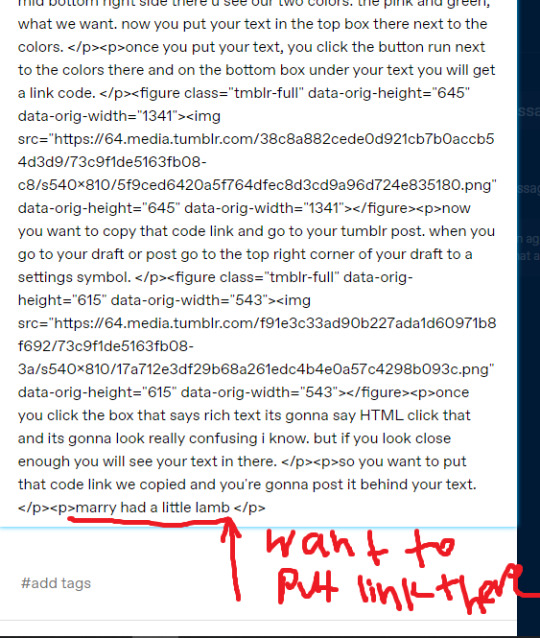
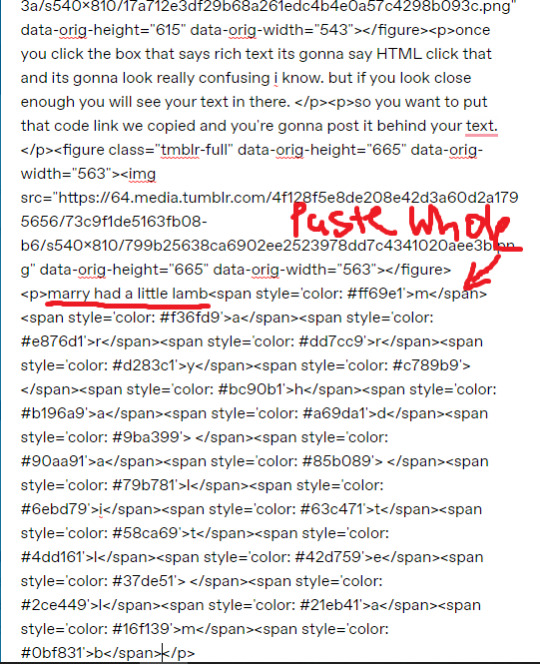
once you do that you want to erase the marry had a little lamb in this case or your text and just leave it to look like <p><span.....and your whole link. once you do that check it thru changing your post from HTML to rich text again.
and it should look a little something like this
marry had a little lamb
now for small text or any text its the same thing so small marry had a little lamb you will do the same thing except leave the word small because thats what makes the text small.
marry had a little lamb
i hope this helped you nonnie and if you ever need help more w this or anything else pls dont hesitate to ask me thru inbox or dm personally i will gladly help! i hope this helps and i know ur blog will look amazing!
#angels asks.#bby anon🐰.#gradient text tutorial#gradient text#tutorial#tumblr tutorial#writing tutorial#blog theme#blog tutorial
142 notes
·
View notes
Text
I Found The Best Framework to Plot My Stories (MICE Quotient Masterclass)
For a long time, I had all of these amazing worlds bouncing around in my head but wasn’t really sure how to bring them to life. When I just free wrote, characters would feel alive, but the plot was a mess and the scenes fell flat. For me, just trying to follow things like the 3 act structure made the pacing go belly up. What the heck are you supposed to do during all of Act Two?
Then, I found the MICE Quotient, and just like that, I had a framework that can work with any story structure. It's specific enough to be useful, but flexible enough to encompass many different story elements. Hopefully, by employing it, you can come up with great stories of your own.
MICE can be used at any length and for any (sequential) story medium. Books, film, tv, comics, et cetera.
I like to think of MICE as the foundation for your story. Each letter represents a different "type" of element. You combine them in unique arrangements to create your unique story.

Each element in MICE is made up of 3 basic parts:
The introduction of the element into the story
The story conflicts as the element try to be resolved
The resolution of the element.
The four elements are Milieu, Inquiry, Character, and Event. We’ll go into depth for all of them, starting with Milieu.
Milieu
The milieu is a character’s environment, where the action happens. A spaceship. Their house. Stories are all about momentum, so this should be a space that facilitates conflict.
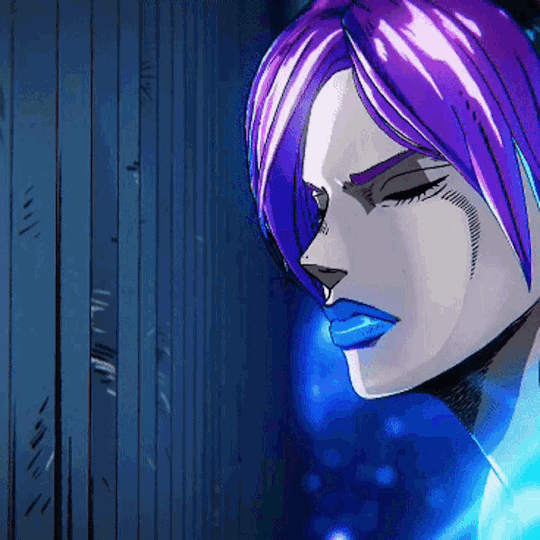
The basic structure of this element is a character enters a new space → they encounter conflicts and obstacles within and relating to this space → the character leaves the space.
Usually, the character’s goal is to leave the space, and your goal as a writer is to be a pain in their rear. You want to systematically prevent them from winning until you finally allow them to succeed.
Inquiry
Next is the Inquiry. It’s all about questions.
This one has a structure where the character has some question → they encounter conflicts and obstacles relating to this question → the character gets the answer.

As a writer, your goal is to make the journey to the answer interesting. Give the character false leads, red herrings, and slight of hands. Once the mystery is solved, the ideal situation is for us to retroactively understand the clues, but not have seen them coming at the same time.
Character
The C in mice stands for Character, which I’ll argue is the most important part of any story. This element is all about the character’s emotions and psychology. The character starts with some angst, and by the end, shifts their mindset in a different direction.
The structure is that: something makes the character realize a flaw → they encounter obstacles and conflicts that make them feel bad as they try to rectify the flaw → the character comes out on the other side, solid in who they are.
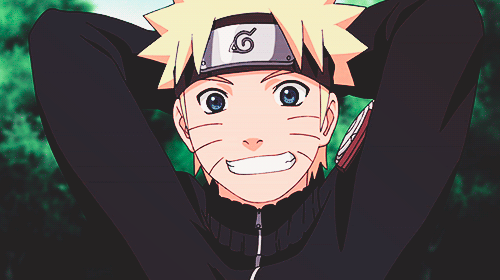
One thing to keep in mind is that this doesn’t always have to be a positive arc. It can also be a character accepting their crappiness. This is all about them becoming who they’re supposed to be. Sometimes that’s just someone who is okay with themselves, warts and all.
Event
Finally, we have the E, the Event. For me, this is one of the easiest ones to grasp.
It’s where a story establishes some status quo -> an Event happens that throws it off -> the characters spend the conflict and obstacle sections trying to restore the status quo.

Usually, this ends up creating a “new normal”. After life-altering events, nothing ever really goes back to exactly how it was before.
So, we have all of our elements. Just from hearing them, you can probably imagine how they can weave in and out of each other and relate. That’s what you want! This is one of those greater than the sum of its parts kinds of situations. Imagine a story where a character is just in the void, angsty for 5 minutes until they have a random epiphany and feel better about themselves. For most people, that probably wouldn’t be a very engaging story! Mixing these elements together in interesting ways and arrangements is what can make your story feel well-designed and exciting.
Before we get into practice, an important thing to note is the nesting aspect of these elements. For my coders, you can think of curly braces or russian dolls. If the first element you use is character, the last you resolve will be that same character element. If Johnny starts the story dealing with social anxiety, the story will end with however he finally addresses that dissonance between who he is and who he wants to be. All the subsequent elements introduced will be resolved before that. It just keeps going, just like Russian dolls.
Example visual of element nesting:
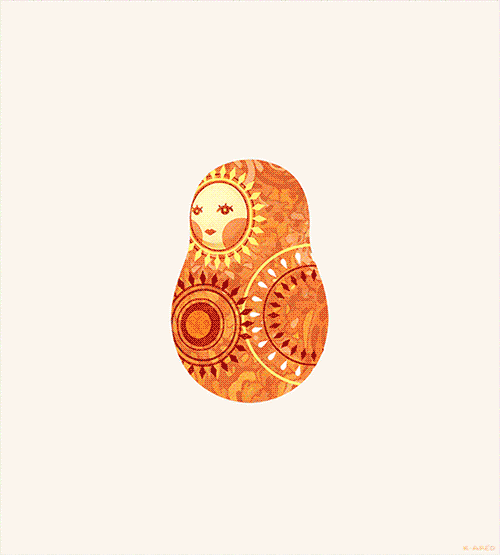
Examples of MICE Quotient in action - Naruto
Now, we’re going to do a couple examples. The first one is from my favorite piece of fiction ever, Naruto. Not to say it’s the best written, but it's the one I consistently enjoy the most. Anyways, let’s break down the first episode of Naruto using the MICE Quotient/Framework thingy. Spoilers for the first episode. If you want to watch it, it’ll be linked here.
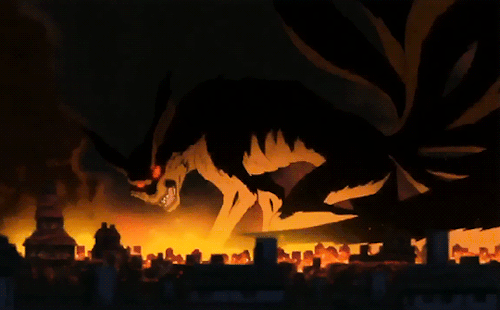
The episode starts with an Event: The nine-tailed fox attacking Naruto’s village. It causes a lot of damage and trouble. To stop it, the leader of the village gives his life to seal it away, inside Naruto.
This leads to our Character element, where Naruto becomes a troublemaker, pining for attention. He wants to be accepted. All that he does is to reach his dream of becoming Hokage since that is what he feels like will ensure his acceptance by the people around him.
The final main MICE element we’ll focus on for the first episode is an Inquiry: How will I pass the academy exam? He tries and initially fails to do the clone Jutsu. This is the third time he’s failed, so it doesn’t look like he’ll ever graduate.
Going back to the curly brace or Russian doll visual, each element is closed in the opposite order of their introduction. So since the Inquiry was introduced last, it gets closed/resolved first. Naruto is able to pass by using the scroll that he was manipulated into stealing to learn the Multi-Shadow Clone Jutsu, a high-level clone jutsu. Don’t ask why this was easier for him than a normal clone.
The Character and Event are also resolved, but much later in the series. I won’t spoil that too much, but just know that they resolve in that same order.
Examples of MICE Quotient in action - Naruto
Hopefully, you’re getting the gist of this. Now, we’ll try it ourselves! I’m going to start with an idea, and use the MICE Quotient to chart out a very broad story outline.
So, after a few minutes of thinking, I came up with a story idea: Something unknown reaches across time and space to teleport humans from different periods and cultures in history, bringing them all to an earthlike-ringworld, a la Halo Infinite.
With that story idea in mind, here’s my MICE Quotient outline.
We start with the I, an Inquiry. We have a researcher who through some excavation, finds some super advanced technology that was buried underground for like forever. He’s trying to answer a question: what are the origins of this tech?
This then leads them to tinker with it, triggering the E, the Event, where they cause some reaction from the technology. A giant flash of light, and POOF! That whole wing of the lab is gone.
We then enter a new M, the Milieu. The researcher and their team find themselves in a new place that seems both familiar and alien.
Through the trials and tribulations of trying to adapt to this situation, we get a C, a Character situation. The researcher realizes their shortcomings as a leader and members of a team. This comes in no small part due to them causing the current situation, along with them trying to lead the survival efforts.
The final new element we get is another E, an Event, where our scientists run into…Ancient Roman soldiers! What the heck!
We then close that E by having them fight and defeat the roman soldiers. How did they do it? I don’t know!
Through this journey with the other scientists, the researcher comes to learn about how to be a better leader and a better team player. That closes the character, the C element.
Once everyone’s able to work together well, they figure out what they need to do to escape. They are able to close the Milieu and leave this new place.
Once they are back on earth, in our time, the Event is resolved, and the status quo is “restored”.
All of this leads to them understanding the truth of how this technology works and where it comes from. This resolves that initial Inquiry at the beginning.
I hope now, you can, with these two examples, relatively confidently apply them to the stories you like, and use that as a springboard for your own stories. From here, you just fill in the insides of the elements with conflicts and story moments, and you’ll have your story! Once I discovered this, it was like being able to see the seams behind a lot of stories in a way that was more useful than some of the other ways that I’ve seen stories be broken down.
---
I hope that all makes sense! Now, try to use the MICE framework to chart out your own stories, and get to writing! See you soon :)
#writing ideas#writing advice#writing#creative wrting#storytelling#writers of tumblr#writers of color#how to write#writing tutorial#writing techniques#writing tips#writing help#writing resources#writerscommunity#writers and poets#writers#creative writing#creative#storytellers#naruto
9 notes
·
View notes
Text
Movies for Writers, Part 1/?
Shutting Your Brain Off
(I've been sitting on this post forever, deciding whether I should post it or not. Ultimately, I settled on posting it 'cause someone somewhere might find it useful. Or, it'll just sit ignored. 🤷🏻♀️😊 Either way, I hope y'all enjoy...)
***
Occasionally, I come across a movie that speaks to me as a writer for various reasons. Sometimes it's the cinematography, sometimes it's the dialogue, sometimes it's the fact that the movie is actually about writing, itself.
Such as the case with this, first movie: Spalding Gray's "Monster in a Box."
***
Here's the IMDB summary:
"Monologuist Spalding Gray talks about the great difficulties he experienced while attempting to write his first novel, a nearly 2,000-page autobiographical tome concerning the death of his mother. Among his many asides, Gray discusses his problems in dealing with the Hollywood film industry, recounts the trips he took around the world in order to avoid dealing with his writer's block and describes his ambivalence about acting as stage manager for a Broadway production of 'Our Town.'"
***
Here the whole dang thing on YouTube:
Monster in the Box
(please let me know if the video comes down, I'll do my best to replace it)
***
Why is this an important watch?
Three main reasons:
Spalding Gray is a brilliant storyteller. Pay attention to the way he phrases things. How & when he decides to drop bits of exposition. This is a monologue, so it's all the power of his words, and his words alone. There is very little production here.
Even with the small amount of production, there is some camera & sound work here. When does he integrate that? How much & why? You can use that in your own writing. When should you add sensory details? When is it best to leave your prose sparse?
Most importantly, the topic of this monologue is writer's block. The dreaded writer's block that we are all faced with at one point or another. There are some valuable lessons to learn here. Spald suffers deeply from his writer's block, so much so that it leads him to several self-discoveries.
***
The first time I watched this was way back in the day as a college student. I'd actually forgotten most of it, but I remember being in awe of his writing talent at the time. Having recently re-watched it (and now that I've been writing more actively) I'm still just as awestruck, but also a lot sad.
Spalding was often plagued by self doubt. That's hit me in all the tender bits on & off lately. This past winter I had a major meltdown over my writing, so watching this was both timely and reassuring for me. I mean, if an individual of Spaulding's caliber can speak openly about his anxieties as a writer, as well as his own battles with writers block, then certainly there is hope for the rest of us. Right? (Goodness, I hope so.)
Ok, I admit it, this might sound like an overly optimistic view of "Monster in a Box," we are talking about the one work that nearly derailed his entire career; however, there's a lesson in how he navigated the disaster.
He set it aside.
He let it breathe.
He turned it into something else!
He let "Monster" be the thing that it needed to be, that it was supposed to be all along. I think that is the biggest lesson I took from my re-watch:
Sometimes your story knows more about itself than you do.
Let that sink it.
Sometimes, it's best to just shut your brain off and write.
✒️✏️💻
I'm currently working on taking Spald's advice.
#Spalding Gray#Monster in a Box#the writing process#writer problems#writing tutorial#let it do what it do#just write it bitch
7 notes
·
View notes
Link
For my fellow writers who want to use more than ‘very whatever’ in their sentences.
3 notes
·
View notes
Text



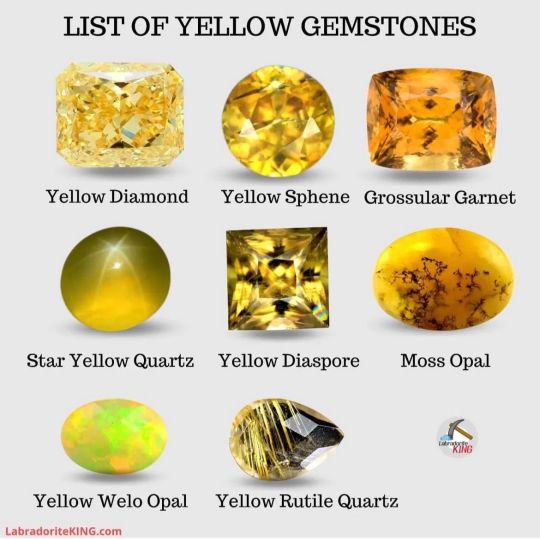
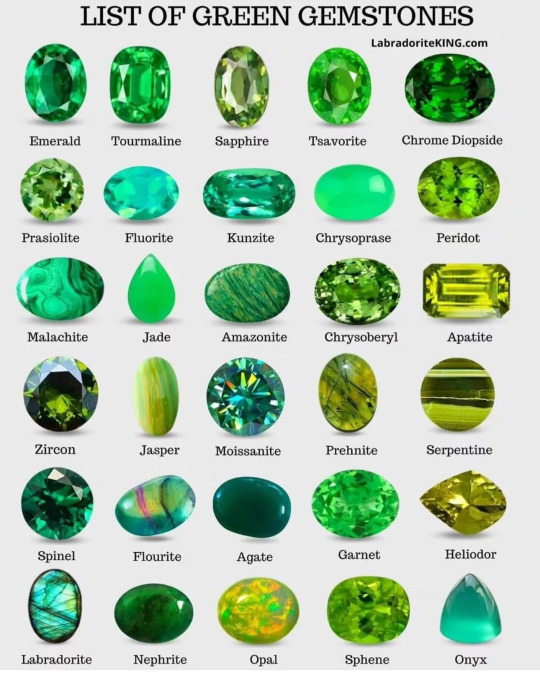
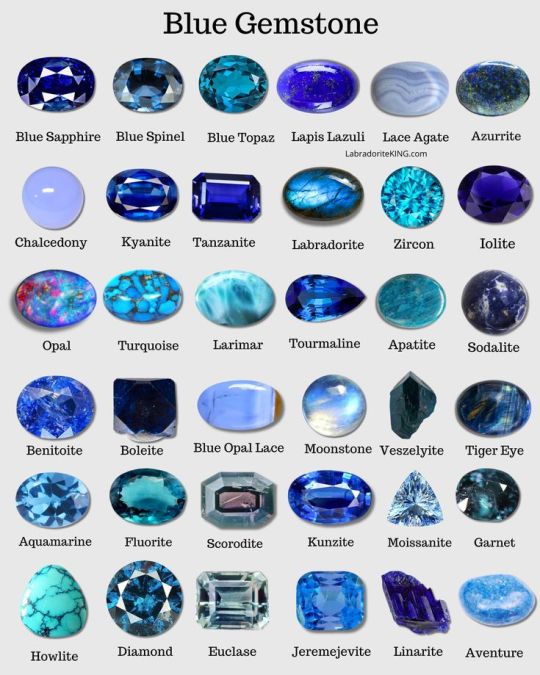
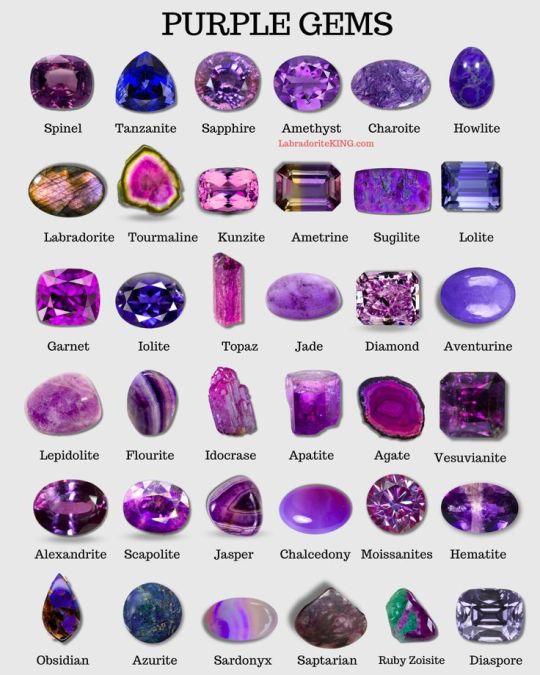
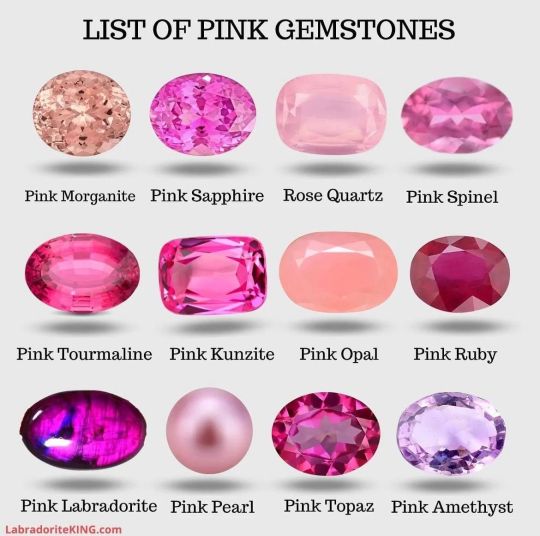
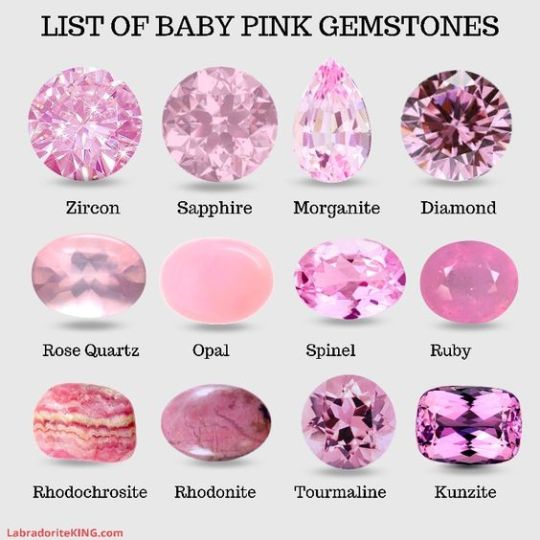
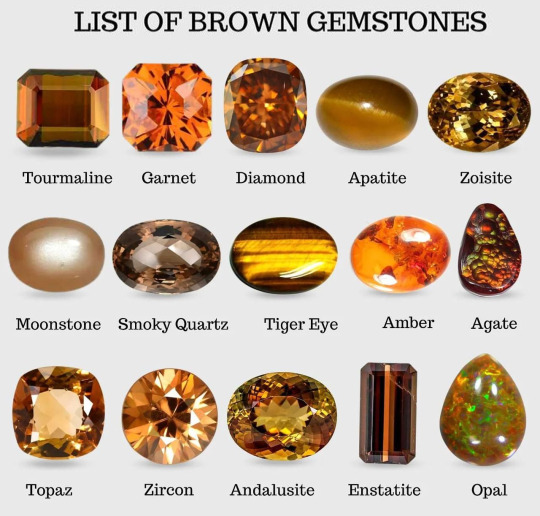
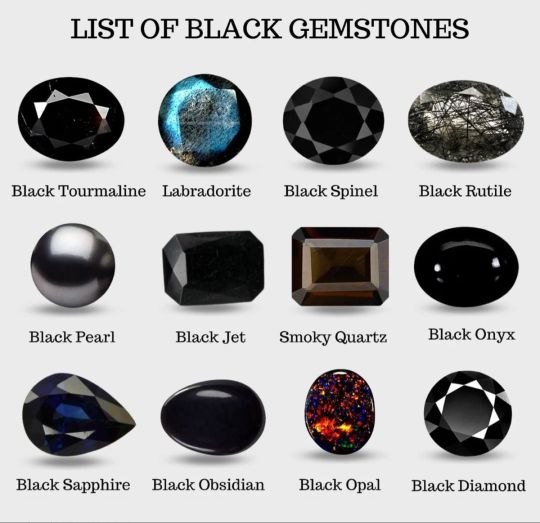

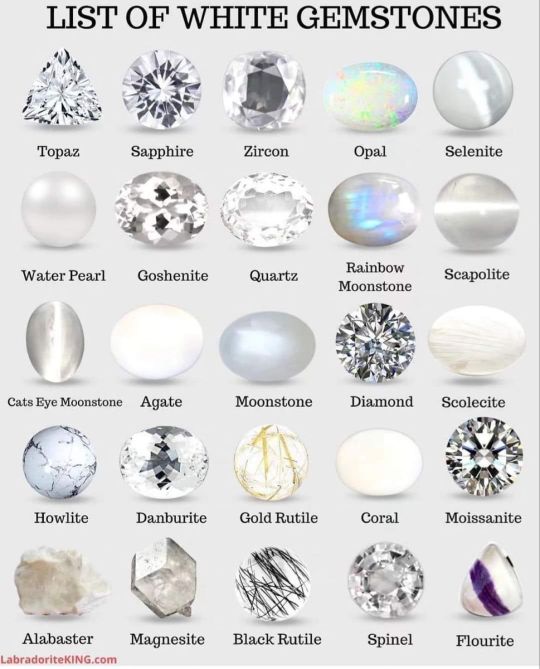
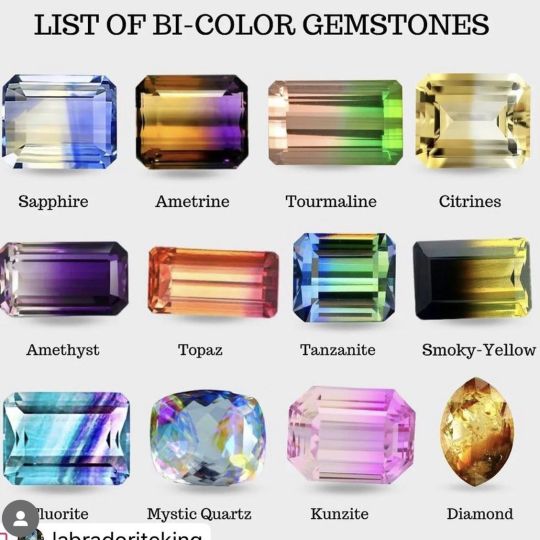
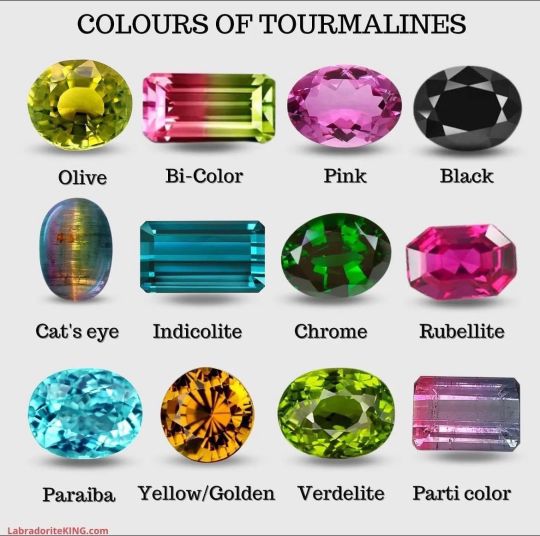
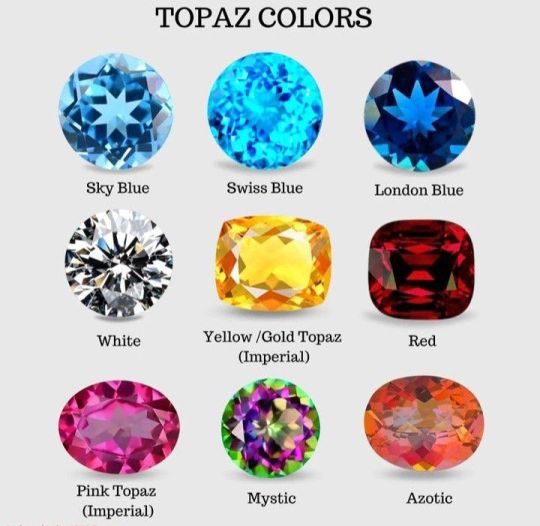

By LabradoriteKing on Pinterest
#Tutorials & References#Gemstones#Jewels#Art Reference#Writing Reference#Gemstones Reference#If the original marker wants me to take this down I will
106K notes
·
View notes
Text
★ ៸៸៸ JEALOUSY ╱ post ❜ ✸ ៸ !?!
Along with many other emotions, jealousy is very complex emotion and requires you to break it down into tiny pieces in order for you to identify and write them.
It is very effective in writing as it helps a character realize what they really want and how badly they want it. It doesn't have to be central to the plot; it can be understated and supported by anger or fear.
It comes across in simple examples like a villain who is jealous of the hero, when two characters want one thing / have the same goal or when one character is more successful than the other.
★ ! THE TYPES ❪ 🎧 ❫ ៸ !?!
# ៸ sexual jealousy ― when a character's spouse or significant other displays or expresses sexual interest in someone else.
# ៸ romantic jealousy ― when your character fears the loss of a romantic partner or fears rejection from a potential or current romantic partner.
# ៸ possessive jealousy ― when he/she feels threatened by someone who could interrupt a friendship or relationship that they value.
# ៸ separation jealousy ― when your character has fear of separation or loss of a lover, partner, friend or parent due to their relationship with another person.
# ៸ work jealousy ― when your character feels cheated out of a promotion at work, or feels jealousy towards a specific person at work.
# ៸ friend / sibling jealousy ― When he/she feels inadequate when comparing themselves to their friends/family/siblings (they always try to one-up their friend/sibling).
# ៸ abnormal jealousy ― extreme psychological jealousy that results in or a combination of morbid, psychotic, psychological, delusional, anxious, controlling, immature and insecure behavior.
★ ! WHAT FUELS IT ❪ 🎧 ❫ ៸ !?!
There are many reason for someone to be jealous of another person. It could be rejection, confusion, frustration, powerlessness, insecurity, suspicion, loneliness or distrust. Choose the reason that fits the type of jealousy.
★ ! HOW IT EFFECTS ❪ 🎧 ❫ ៸ !?!
Do they have an increased heart rate or body temperature? Do they become angry and clench their fist, have verbal outbursts, stare downs and tensed muscles? Do they become quiet and have a dry mouth?
★ ! THEIR REACTION ❪ 🎧 ❫ ៸ !?!
★ make up stories/gossip about that person so that others will have negative feelings towards the same person.
★ feel overwhelmed and underachieve in every sphere of their life.
★ avoid the person all together.
★ take up a bad habit or addiction in an attempt to deal with their feelings.
★ become obsessed about something (like over exercising and dieting to beat their rival in a tournament or something more sinister like plotting another character’s demise).
★ manipulate others into feeling sorry for them.
★ over criticize themselves and everything they do.
★ harm themselves, their environment or others.
★ show a blatant disregard for the needs and desires of others to fulfill their own.
★ bully or intimidate the people around them to gain a false sense of power.
★ abuse others physically or psychologically.
★ flaunt their wealth (or fame, intelligence, status, beauty, etc.) to mask their own insecurities.



#writing advice#writingadvice#writingtips#writing tips#fictionwriting#writersociety#writing promps#writing tutorial#writing help#writing tricks#character tips#writers on tumblr#moon-delia#quirks#character quirks
543 notes
·
View notes
Text
A general cane guide for writers and artists (from a cane user, writer, and artist!)
Disclaimer: Though I have been using a cane for 6 years, I am not a doctor, nor am I by any means an expert. This guide is true to my experience, but there are as many ways to use a cane as there are cane users!
This guide will not include: White canes for blindness, crutches, walkers, or wheelchairs as I have no personal experience with these.
This is meant to be a general guide to get you started and avoid some common mishaps/misconceptions in your writing, but you absolutely should continue to do your own research outside of this guide!
This is NOT a medical resource!!! And never tell a real person you think they're using a cane wrong!

The biggest recurring problem I've seen is using the cane on the wrong side. The cane goes on the opposite side of the pain! If your character has even-sided pain or needs it for balance/weakness, then use the cane in the non-dominant hand to keep the dominant hand free. Some cane users also switch sides to give their arm a rest!
A cane takes about 20% of your weight off the opposite leg. It should fit within your natural gait and become something of an extension of your body. If you need more weight off than 20%, then crutches, a walker, or a wheelchair is needed.
Putting more pressure on the cane, using it on the wrong side, or having it at the wrong height can make it less effective, and can cause long term damage to your body from improper pressure and posture. (Hugh Laurie genuinely hurt his body from years of using a cane wrong on House!)
(some people elect to use a cane wrong for their personal situation despite this, everyone is different!)
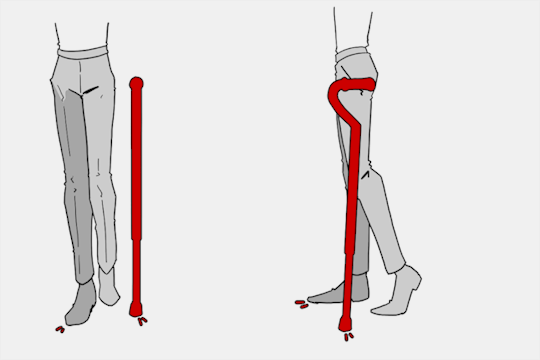
(an animated GIF of a cane matching the natural walking gait. It turns red when pressure is placed on it.)
When going up and down stairs, there is an ideal standard: You want to use the handrail and the cane at the same time, or prioritize the handrail if it's only on one side. When going up stairs you lead with your good leg and follow with the cane and hurt leg together. When going down stairs you lead with the cane and the bad leg and follow with the good leg!
Realistically though, many people don't move out of the way for cane users to access the railing, many stairs don't have railings, and many are wet, rusty, or generally not ideal to grip.
In these cases, if you have a friend nearby, holding on to them is a good idea. Or, take it one step at a time carefully if you're alone.
Now we come to a very common mistake I see... Using fashion canes for medical use!
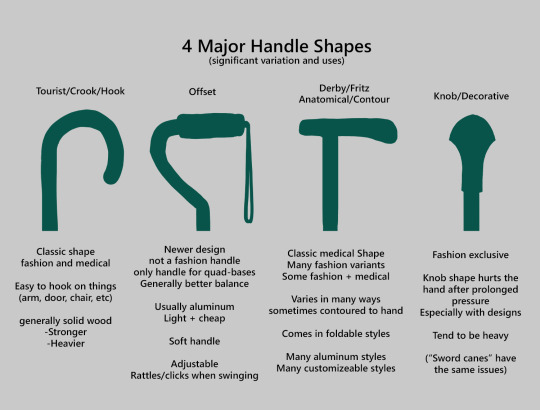
(These are 4 broad shapes, but there is INCREDIBLE variation in cane handles. Research heavily what will be best for your character's specific needs!)
The handle is the contact point for all the weight you're putting on your cane, and that pressure is being put onto your hand, wrist, and shoulder. So the shape is very important for long term use!
Knob handles (and very decorative handles) are not used for medical use for this reason. It adds extra stress to the body and can damage your hand to put constant pressure onto these painful shapes.
The weight of a cane is also incredibly important, as a heavier cane will cause wear on your body much faster. When you're using it all day, it gets heavy fast! If your character struggles with weakness, then they won't want a heavy cane if they can help it!
This is also part of why sword canes aren't usually very viable for medical use (along with them usually being knob handles) is that swords are extra weight!
However, a small knife or perhaps a retractable blade hidden within the base might be viable even for weak characters.
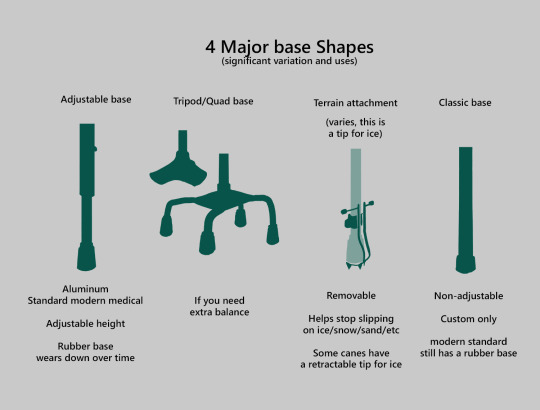
Bases have a lot of variability as well, and the modern standard is generally adjustable bases. Adjustable canes are very handy if your character regularly changes shoe height, for instance (gotta keep the height at your hip!)
Canes help on most terrain with their standard base and structure. But for some terrain, you might want a different base, or to forego the cane entirely! This article covers it pretty well.
Many cane users decorate their canes! Stickers are incredibly common, and painting canes is relatively common as well! You'll also see people replacing the standard wrist strap with a personalized one, or even adding a small charm to the ring the strap connects to. (nothing too large, or it gets annoying as the cane is swinging around everywhere)
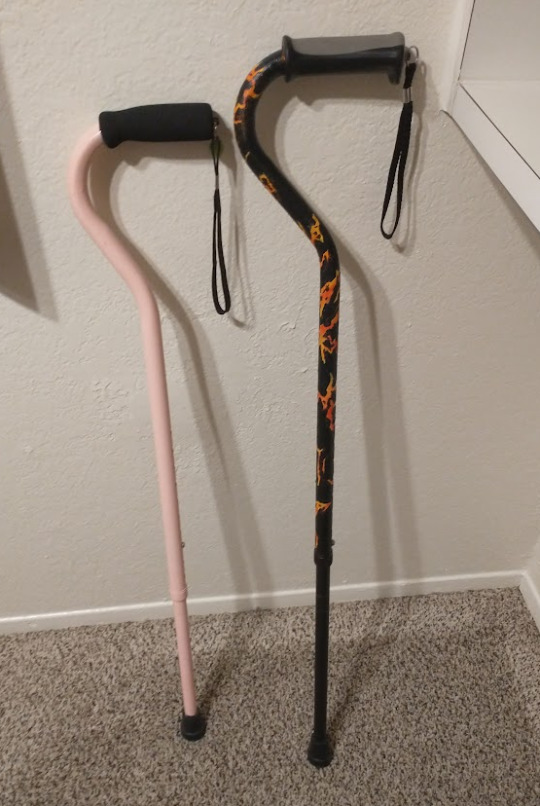
(my canes, for reference)
If your character uses a cane full time, then they might also have multiple canes that look different aesthetically to match their outfits!
When it comes to practical things outside of the cane, you reasonably only have one hand available while it's being used. Many people will hook their cane onto their arm or let it dangle on the strap (if they have one) while using their cane arm, but it's often significantly less convenient than 2 hands. But, if you need 2 hands, then it's either setting the cane down or letting it hang!
For this reason, optimizing one handed use is ideal! Keeping bags/items on the side of your free hand helps keep your items accessible.

When sitting, the cane either leans against a wall or table, goes under the chair, or hooks onto the back of the chair. (It often falls when hanging off of a chair, in my experience)
When getting up, the user will either use their cane to help them balance/support as they stand, or get up and then grab their cane. This depends on what it's being used for (balance vs pain when walking, for instance!)
That's everything I can think of for now. Thank you for reading my long-but-absolutely-not-comprehensive list of things to keep in mind when writing or drawing a cane user!
Happy disability pride month! Go forth and make more characters use canes!!!
#mobility aid#cane user#writing tips#writing advice#drawing tips#art tutorial#art tips#art reference#art resources#art help#my art#long post
73K notes
·
View notes
Text
📚 A List Of Useful Websites When Making An RPG 📚
My timeloop RPG In Stars and Time is done! Which means I can clear all my ISAT gamedev related bookmarks. But I figured I would show them here, in case they can be useful to someone. These range from "useful to write a story/characters/world" to "these are SUPER rpgmaker focused and will help with the terrible math that comes with making a game".
This is what I used to make my RPG game, but it could be useful for writers, game devs of all genres, DMs, artists, what have you. YIPPEE
Writing (Names)
Behind The Name - Why don't you have this bookmarked already. Search for names and their meanings from all over the world!
Medieval Names Archive - Medieval names. Useful. For ME
City and Town Name Generator - Create "fake" names for cities, generated from datasets from any country you desire! I used those for the couple city names in ISAT. I say "fake" in quotes because some of them do end up being actual city names, especially for french generated ones. Don't forget to double check you're not 1. just taking a real city name or 2. using a word that's like, Very Bad, especially if you don't know the country you're taking inspiration from! Don't want to end up with Poopaville, USA
Writing (Words)
Onym - A website full of websites that are full of words. And by that I mean dictionaries, thesauruses, translators, glossaries, ways to mix up words, and way more. HIGHLY recommend checking this website out!!!
Moby Thesaurus - My thesaurus of choice!
Rhyme Zone - Find words that rhyme with others. Perfect for poets, lyricists, punmasters.
In Different Languages - Search for a word, have it translated in MANY different languages in one page.
ASSETS
In general, I will say: just look up what you want on itch.io. There are SO MANY assets for you to buy on itch.io. You want a font? You want a background? You want a sound effect? You want a plugin? A pixel base? An attack animation? A cool UI?!?!?! JUST GO ON ITCH.IO!!!!!!
Visual Assets (General)
Creative Market - Shop for all kinds of assets, from fonts to mockups to templates to brushes to WHATEVER YOU WANT
Velvetyne - Cool and weird fonts
Chevy Ray's Pixel Fonts - They're good fonts.
Contrast Checker - Stop making your text white when your background is lime green no one can read that shit babe!!!!!!
Visual Assets (Game Focused)
Interface In Game - Screenshots of UI (User Interfaces) from SO MANY GAMES. Shows you everything and you can just look at what every single menu in a game looks like. You can also sort them by game genre! GREAT reference!
Game UI Database - Same as above!
Sound Assets
Zapsplat, Freesound - There are many sound effect websites out there but those are the ones I saved. Royalty free!
Shapeforms - Paid packs for music and sounds and stuff.
Other
CloudConvert - Convert files into other files. MAKE THAT .AVI A .MOV
EZGifs - Make those gifs bigger. Smaller. Optimize them. Take a video and make it a gif. The Sky Is The Limit
Marketing
Press Kitty - Did not end up needing this- this will help with creating a press kit! Useful for ANY indie dev. Yes, even if you're making a tiny game, you should have a press kit. You never know!!!
presskit() - Same as above, but a different one.
Itch.io Page Image Guide and Templates - Make your project pages on itch.io look nice.
MOOMANiBE's IGF post - If you're making indie games, you might wanna try and submit your game to the Independent Game Festival at some point. Here are some tips on how, and why you should.
Game Design (General)
An insightful thread where game developers discuss hidden mechanics designed to make games feel more interesting - Title says it all. Check those comments too.
Game Design (RPGs)
Yanfly "Let's Make a Game" Comics - INCREDIBLY useful tips on how to make RPGs, going from dungeons to towns to enemy stats!!!!
Attack Patterns - A nice post on enemy attack patterns, and what attacks you should give your enemies to make them challenging (but not TOO challenging!) A very good starting point.
How To Balance An RPG - Twitter thread on how to balance player stats VS enemy stats.
Nobody Cares About It But It’s The Only Thing That Matters: Pacing And Level Design In JRPGs - a Good Post.
Game Design (Visual Novels)
Feniks Renpy Tutorials - They're good tutorials.
I played over 100 visual novels in one month and here’s my advice to devs. - General VN advice. Also highly recommend this whole blog for help on marketing your games.
I hope that was useful! If it was. Maybe. You'd like to buy me a coffee. Or maybe you could check out my comics and games. Or just my new critically acclaimed game In Stars and Time. If you want. Ok bye
#reference#tutorial#writing#rpgmaker#renpy#video games#game design#i had this in my drafts for a while so you get it now. sorry its so long#long post
4K notes
·
View notes